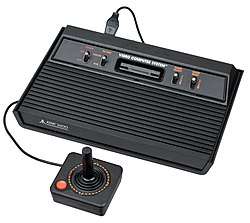MOS Technology 6507
The 6507 (typically "sixty-five-oh-seven" or "six-five-oh-seven") is an 8-bit microprocessor from MOS Technology, Inc. It is a version of their 6502 packaged in a 28-pin DIP, which makes it cheaper to package and integrate in systems. The reduction in pin count is achieved by reducing the address bus from 16 bits to 13 (limiting the available memory range from 64 KB to 8 KB) and removing a number of other pins used only for certain applications.
 | |
| General Info | |
|---|---|
| Launched | 1975 |
| Common manufacturer(s) | |
| Performance | |
| Data width | 8 |
| Address width | 13 |
| Architecture and classification | |
| Instruction set | 6502 |
| Instructions | 56 |
| Physical specifications | |
| Transistors | |
| Package(s) |
|
| History | |
| Predecessor |
|
To do this, A15 to A13 and some other signals such as the interrupt lines are not accessible. As a result, it can only address 8 KB of memory, which for some applications at the time (1975) was acceptable and not overly restrictive. The entire 65xx CPU family was originally conceived as a line of very low-cost microprocessors for small-scale embedded systems, not general-purpose computers and certainly not interactive personal computers (which did not generally exist yet).[3]
The 6507 and 6502 chips use the same underlying silicon layers, and differ only in the final metallisation layer. This ties the interrupt lines to their inactive level so that they are not vulnerable to generating spurious interrupts from noise. The first three digits of the chip identifier are part of the silicon layers, and the final digit is in the metallisation layer. Micro-photography of the 6502 and 6507 shows this difference.[4]

The 6507 was only widely used in two applications: the best-selling Atari 2600 video game console and Atari 8-bit family peripherals including the 850 Serial & Parallel Interface, and floppy disk controllers for the 810 and 1050 disk drives. In the 2600, the system was further limited by the design of the ROM cartridge slot, which allowed for only 4 KB of external memory to be addressed. The other 4 KB was reserved for the internal RAM and I/O chips, using a minimal-cost partial decoding technique that caused the RAM and peripheral device registers to appear at multiple 'ghost' addresses throughout the 4 KB.
Most other machines, notably home computers based on the 650x architecture, used either the standard 6502 or extended, rather than cut down, versions of it, in order to allow for more memory.
By the time the 6502 line was becoming widely used around 1980, ROM and RAM semiconductor memory prices had fallen to the point where the 6507 was no longer a worthwhile simplification. Its use in new designs ceased at that point, though the Atari 2600 that contained it continued to be sold into the early 1990s, as it was not discontinued until January 1, 1992. However, late-model Atari 2600 consoles were redesigned, highly integrated "2600 jr" units that did not necessarily contain a separate 6507 chip, as they might have integrated the CPU into an custom ASIC.
Pin configuration
| /RES | 1 | 28 | Ph2 out |
| Vss | 2 | 27 | Ph0 in |
| RDY | 3 | 26 | R/W |
| Vcc | 4 | 25 | D0 |
| A0 | 5 | 24 | D1 |
| A1 | 6 | 23 | D2 |
| A2 | 7 | 22 | D3 |
| A3 | 8 | 21 | D4 |
| A4 | 9 | 20 | D5 |
| A5 | 10 | 19 | D6 |
| A6 | 11 | 18 | D7 |
| A7 | 12 | 17 | A12 |
| A8 | 13 | 16 | A11 |
| A9 | 14 | 15 | A10 |
The 6507 uses a 28-pin configuration, with 13 address pins and 8 data pins. The seven remaining pins are used for power, the CPU timing clock, to reset the CPU, to request bus wait states (the RDY pin), and for read/write commands to memory (or MMIO devices) from the CPU. There is no IRQ or NMI pin on the processor.
The RDY pin is not included on all other 28-pin cut-down versions of the 6502. Within the Atari 2600, RDY is used to synchronise the CPU to the television video frame. This function is essential for the 'racing the beam' method used by the 6502 and Atari Television Interface Adaptor chip to generate the television video signal. In response to a specific register access, the TIA will assert RDY to extend that bus cycle until the end of the current video scan line.
References
- "The MOS 6502 and the Best Layout Guy in the World". swtch.com. 2011-01-03. Retrieved 2014-08-09.
- "MOnSter6502". monster6502.com. 2017. Retrieved 2017-05-01.
- The entire reason that Chuck Peddle designed the 6502 in the first place was to offer an inexpensive alternative to the $175 Motorola 6800 and to the comparably priced Intel 8080, the high costs of which made many interesting commercial and consumer embedded-microprocessor product ideas (such as inexpensive advanced cash registers, computerized pinball machines, and computer-controlled stereo systems) not economically feasible.
- Visual6502. "Visual6502.org: 6502 vs. 6507".
- Peter Turnbull (January 25, 2005). "MOS 6507 Tech Spec's".